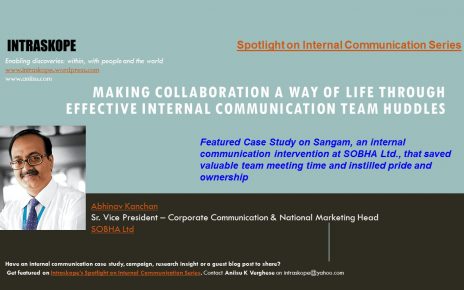With the dust settling after the successful completion of the Delhi 2010 Commonwealth Games many organizations in India are either heaving a sigh of relief or are simply delighted not just because we came second in the ranking but also since their business operations ran smoothly.
I can relate to the event and how we kept internal stakeholders in the loop with a structured communication plan and ready-to-use material well ahead and after the Games. I am sure many organizations prepared well to avoid any last minute rushes.
Here is the context before I dive into what challenges we foresaw and preempted with timely internal communication and initiatives.
The Games (October 3-14) was slated as the biggest multi – sport event conducted in India so far. With over 70 countries fielding teams and 3400 sports persons and 12000 delegates participating there were always going to be potential hurdles with employee availability, transport, accommodation, road passage and travel plans.

So even if you didn’t have an office in Delhi there could have been impact to work – with keeping clients informed, employees commuting to and from office, stakeholders transiting the country or someone needing visas to travel among others.
To begin, a core team comprising leadership and internal groups (office administration, internal communication, human resources among others) discussed potential concerns and challenges that the Games could throw at us.
A comprehensive business continuity and communication plan ensured that we shared updates with key stakeholders, anticipated scenarios and potential costs.
Experience matters: While employees knew that the organization had little control over what happened during the Games and the condition of the roads they expected to be involved and kept abreast of positive steps taken to improve their overall experience during that period. A central helpdesk allowed employees to seek clarifications on transport and potential issues that could crop up. Leaders were nominated to front-end any direct conversations and we listed key contacts on the intranet.
Crowdsourcing – a game changer: By inviting employees to play the ‘eyes and ears’ of the organization it helped us plan business contingencies better. For example, employees sent in presentations and other material they sourced from the Web pointing to impacted roads and other scenarios that we didn’t anticipate earlier. An employee who enrolled as a volunteer with the Commonwealth Games team had insights on areas to avoid during the event. Similarly, employees were asked to define what time worked best for them so that they could plan their work better and keep their stakeholders informed.
Better safe than sorry: By deciding to shutter the office during the Games’ closing ceremony and work on an alternate day we were taking no chances with enough warnings of chaos and increased security measures. It turned out that we made the right move – we heard about 75000 people attended the finale.
Travel with discretion: Even though we had visitors and clients coming in during the fortnight expectations were set on what they could see in the city and the inconvenience that they might face. There were questions on terror threats and if the event would finally get held apart from the news on corruption. Travelers were pointed to the CWG website, the internal intranet page and travel guidance for their clarifications. Advisories were published periodically so that all travelers were on the same page.
Transport blues: Most companies anticipated fewer cabs and even lesser drivers since most were going to be engaged during the Games. We preempted this by ensuring the company accounted for more vehicles, rescheduled pick-up and drops, leveraged the Metro and encouraged employees to car pool.
Saving for a rainy day: By stocking up dry food, fuel for generators, pre-booking guest houses in case of stay-overs and investing in back-ups for the premises we saved for a rainy day. Clients and partners were informed of our plans and kept in the loop of changes as we progressed. Laptops were provided to teams with critical needs.
Engaging employees with internal communication: Internal communication had a pivotal role to play in this exercise. Employees and leaders were requested to share updates with stakeholders, think of options to work from home if possible, retain key emergency numbers and ensure team members were equipped with spare laptops to tide over any eventuality. They were encouraged to carry their car papers and identification cards in case of security checks on Delhi roads.
Answering pertinent questions: Not surprisingly employees had many questions about safety, their role in the process, next steps in an emergency and if could work from home. By articulating these as consistent messages and cascading it through leaders allowed meaningful conversations and timely information sharing.
Crisis situations are welcome at times: This specific event gave us the opportunity to rally employees together, to work collaboratively, update their contact information (we had challenges with employees keeping their profiles current) and building rigor into business continuity planning.
I personally learnt from this experience – in terms of helping stakeholders plan ahead with their communication, agree on consistent messages and believe in sharing it widely.
